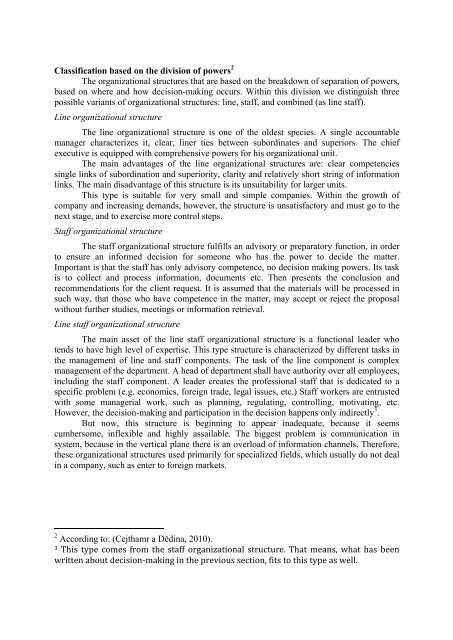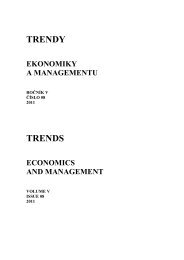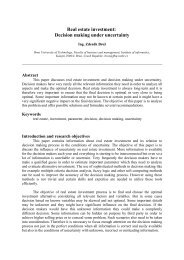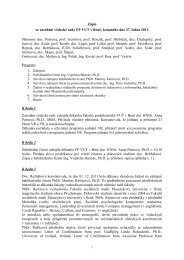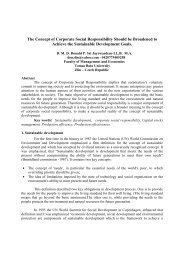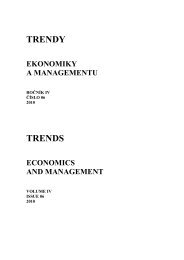Research into the usage of organizational structures in the Czech ...
Research into the usage of organizational structures in the Czech ...
Research into the usage of organizational structures in the Czech ...
Create successful ePaper yourself
Turn your PDF publications into a flip-book with our unique Google optimized e-Paper software.
Classification based on <strong>the</strong> division <strong>of</strong> powers 2<br />
The <strong>organizational</strong> <strong>structures</strong> that are based on <strong>the</strong> breakdown <strong>of</strong> separation <strong>of</strong> powers,<br />
based on where and how decision-mak<strong>in</strong>g occurs. With<strong>in</strong> this division we dist<strong>in</strong>guish three<br />
possible variants <strong>of</strong> <strong>organizational</strong> <strong>structures</strong>: l<strong>in</strong>e, staff, and comb<strong>in</strong>ed (as l<strong>in</strong>e staff).<br />
L<strong>in</strong>e <strong>organizational</strong> structure<br />
The l<strong>in</strong>e <strong>organizational</strong> structure is one <strong>of</strong> <strong>the</strong> oldest species. A s<strong>in</strong>gle accountable<br />
manager characterizes it, clear, l<strong>in</strong>er ties between subord<strong>in</strong>ates and superiors. The chief<br />
executive is equipped with comprehensive powers for his <strong>organizational</strong> unit.<br />
The ma<strong>in</strong> advantages <strong>of</strong> <strong>the</strong> l<strong>in</strong>e <strong>organizational</strong> <strong>structures</strong> are: clear competencies<br />
s<strong>in</strong>gle l<strong>in</strong>ks <strong>of</strong> subord<strong>in</strong>ation and superiority, clarity and relatively short str<strong>in</strong>g <strong>of</strong> <strong>in</strong>formation<br />
l<strong>in</strong>ks. The ma<strong>in</strong> disadvantage <strong>of</strong> this structure is its unsuitability for larger units.<br />
This type is suitable for very small and simple companies. With<strong>in</strong> <strong>the</strong> growth <strong>of</strong><br />
company and <strong>in</strong>creas<strong>in</strong>g demands, however, <strong>the</strong> structure is unsatisfactory and must go to <strong>the</strong><br />
next stage, and to exercise more control steps.<br />
Staff <strong>organizational</strong> structure<br />
The staff <strong>organizational</strong> structure fulfills an advisory or preparatory function, <strong>in</strong> order<br />
to ensure an <strong>in</strong>formed decision for someone who has <strong>the</strong> power to decide <strong>the</strong> matter.<br />
Important is that <strong>the</strong> staff has only advisory competence, no decision mak<strong>in</strong>g powers. Its task<br />
is to collect and process <strong>in</strong>formation, documents etc. Then presents <strong>the</strong> conclusion and<br />
recommendations for <strong>the</strong> client request. It is assumed that <strong>the</strong> materials will be processed <strong>in</strong><br />
such way, that those who have competence <strong>in</strong> <strong>the</strong> matter, may accept or reject <strong>the</strong> proposal<br />
without fur<strong>the</strong>r studies, meet<strong>in</strong>gs or <strong>in</strong>formation retrieval.<br />
L<strong>in</strong>e staff <strong>organizational</strong> structure<br />
The ma<strong>in</strong> asset <strong>of</strong> <strong>the</strong> l<strong>in</strong>e staff <strong>organizational</strong> structure is a functional leader who<br />
tends to have high level <strong>of</strong> expertise. This type structure is characterized by different tasks <strong>in</strong><br />
<strong>the</strong> management <strong>of</strong> l<strong>in</strong>e and staff components. The task <strong>of</strong> <strong>the</strong> l<strong>in</strong>e component is complex<br />
management <strong>of</strong> <strong>the</strong> department. A head <strong>of</strong> department shall have authority over all employees,<br />
<strong>in</strong>clud<strong>in</strong>g <strong>the</strong> staff component. A leader creates <strong>the</strong> pr<strong>of</strong>essional staff that is dedicated to a<br />
specific problem (e.g. economics, foreign trade, legal issues, etc.) Staff workers are entrusted<br />
with some managerial work, such as plann<strong>in</strong>g, regulat<strong>in</strong>g, controll<strong>in</strong>g, motivat<strong>in</strong>g, etc.<br />
However, <strong>the</strong> decision-mak<strong>in</strong>g and participation <strong>in</strong> <strong>the</strong> decision happens only <strong>in</strong>directly 3 .<br />
But now, this structure is beg<strong>in</strong>n<strong>in</strong>g to appear <strong>in</strong>adequate, because it seems<br />
cumbersome, <strong>in</strong>flexible and highly assailable. The biggest problem is communication <strong>in</strong><br />
system, because <strong>in</strong> <strong>the</strong> vertical plane <strong>the</strong>re is an overload <strong>of</strong> <strong>in</strong>formation channels. Therefore,<br />
<strong>the</strong>se <strong>organizational</strong> <strong>structures</strong> used primarily for specialized fields, which usually do not deal<br />
<strong>in</strong> a company, such as enter to foreign markets.<br />
2 Accord<strong>in</strong>g to: (Cejthamr a Děd<strong>in</strong>a, 2010).<br />
3 This type comes from <strong>the</strong> staff <strong>organizational</strong> structure. That means, what has been <br />
written about decision-‐mak<strong>in</strong>g <strong>in</strong> <strong>the</strong> previous section, fits to this type as well.


